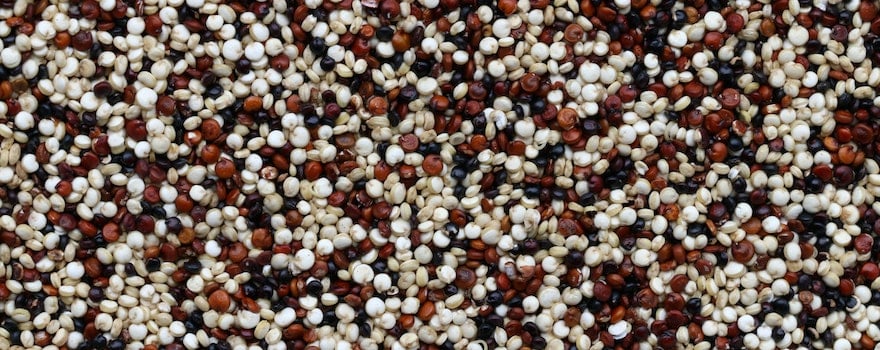BENEFITS OF QUINOA
✓ Source of plant-based protein
✓ Improves diabetes
✓ Anti-inflammatory
✓ Helps with weight loss
✓ Potentially anti-cancer
What is quinoa?
Like amaranth, quinoa (Chenopodium quinoa) is an herbaceous plant of the Amaranthaceae family. It is therefore not a cereal (which belongs to the grass family) but a pseudocereal like buckwheat or chia. Despite this botanical distinction, its seeds are consumed in the same way as cereals.
Quinoa grows in South America (Peru, Bolivia, Ecuador…), in high-altitude regions. It is a particularly hardy plant that adapts to all types of soil, even poor ones. Typical of the Andes, it was already cultivated by the pre-Columbian peoples. Among the Incas, the seeds were an integral part of the staple diet. The earliest evidence of its cultivation dates back to about 5000 years BCE.
Its current popularity is largely due to the nutritional benefits of its seeds. Indeed, they have a high content of plant-based proteins. They also have anti-inflammatory effects, may help improve diabetes, aid in weight loss, and may have anticancer properties.
Like moringa or spirulina, it is one of the best ingredients to fight malnutrition. In 2013, the “International Year of Quinoa”, the UN highlighted its contribution to global food security. Because of its nutritional richness, it is an important food source for developing countries.
Nutritional composition
- Acides aminés dont les 8 essentiels
- Vitamines : B1, B2, B3, B5, B6, B9, E
- Minéraux et oligo-éléments : manganèse, fer, cuivre, phosphore, magnésium, zinc, calcium, potassium
- Lipides
- Protéines
- Glucides
- Fibres
- Acides gras : oméga 3
- Actifs antioxydants : bétacyanines, polyphénols, flavonoïdes
- Saponines

Benefits of quinoa
🌿 Source of plant-based protein
Quinoa is an excellent source of plant-based proteins. In fact, 100 g of seeds provide about 15 g of protein to the body. It thus joins the list of ingredients richest in plant-based proteins, alongside chia seeds, goji berries or hemp seeds. This makes it particularly interesting for vegetarians, plant-based eaters, or vegans to avoid protein deficiencies.
Furthermore, its proteins are considered “complete” because they contain all the essential amino acids for the human body. They are particularly high in lysine, methionine and cystine.
This review from Shahid Beheshti University of Medical Sciences in Tehran (Iran) focused on the composition, structure and properties of quinoa proteins.
🍭 Improves diabetes
Quinoa stands out for its high dietary fiber content : about 10 g per 100 g. It is mainly soluble fiber which, once in contact with water, turns into a viscous gel. This gel slows carbohydrate absorption, allowing better blood sugar control.
Its fibers notably limit blood sugar spikes after meals and lower the level of glycated hemoglobin that determines blood glucose levels.
This study from the Catholic University of Murcia (Spain), conducted in prediabetic patients, shows the benefit of quinoa in improving diabetes.
🔥 Anti-inflammatory
Like the seeds of nigella or fenugreek, quinoa seeds contain saponins. These natural molecules target inflammation and help reduce it effectively. They provide relief for joint pain, arthritis, osteoarthritis, or inflammatory bowel diseases.
Its saponins inhibit tumor necrosis factor (TNF) and prevent the release of cytokines (interleukin-6) that contribute to the inflammatory response.
This study from the Chinese Academy of Agricultural Sciences in Beijing (China), conducted on cells, shows the anti-inflammatory activity of quinoa saponins.
🏃🏻♂️ Helps with weight loss
Because it’s rich in fiber and protein, quinoa contributes to healthy weight loss. In the stomach, its soluble fibers form a viscous gel that promotes the feeling of fullness and slows gastric emptying. It is a valuable ally against snack cravings during the day.
In addition, it improves digestion and regulates intestinal transit. It thus helps to keep a flat stomach.
This study from the Defence Food Research Laboratory (India), carried out on rats, shows the value of quinoa in controlling weight and combating obesity.
🔬 Potentially anti-cancer
Quinoa seeds also contain antioxidant compounds including betacyanins, polyphenols and flavonoids. These substances effectively fight free radicals but also cancer cells. Thus, these antioxidants prevent the proliferation of diseased cells and induce their apoptosis (programmed cell death).
This study from Chengdu University (China), conducted on human cells, shows the anti-cancer effects of quinoa.

How to eat quinoa?
Quinoa seeds
Different varieties : red quinoa, white (or blond) quinoa and black quinoa. They differ in color, texture and taste, which can be more or less pronounced. However, there are few differences from a nutritional standpoint.
The seeds have a mild flavor, close to hazelnut. They are eaten cooked, plain or as an accompaniment in salads, vegetable, meat, or fish dishes… These seeds are also ideal for making tabbouleh, porridges, mueslis, and homemade cereal bars.
For cooking, count on 80g of dry seeds per person. Rinse them in a fine sieve and cook them in twice their volume of water, bring to a boil, then simmer for 10 minutes over low heat. Finally, let them sit for 5 minutes off the heat.

Quinoa flour
Quinoa flour, obtained after grinding the seeds, has the advantage of being gluten-free. It therefore makes an interesting alternative for people who are intolerant to, allergic to, or sensitive to gluten. It has a pleasant nutty flavor but a slight bitter taste.
You can use it to replace wheat flour or in combination with other gluten-free flours such as rice flour, buckwheat flour, or corn flour. This flour is well suited to making cakes and pastries, breads, pasta… It also helps thicken sauces and soups.
Quinoa flakes
Like oat flakes, quinoa flakes can be used to make mueslis for breakfast, vegetarian patties, cereal bars… Convenient and easy to use in the kitchen, they will let you enjoy yourself in a thousand and one ways ! They have a fairly neutral taste, are finer than oat flakes, and are very easy to digest.

Consume sustainably: prefer organic, local, and fair-trade quinoa
✓ Peru, Bolivia and Ecuador are the main producing countries. But, faced with growing demand, its cultivation has gradually spread around the world : United States, China, India, Canada, Australia and even France.
✓ In France, more and more farmers are planting it on their plots. In Anjou, for example, red quinoa has adapted and provides good harvests: in 2020, 375 farmers harvested 4,000 tons. If you can, choose quinoa grown in France and organic.
✓ The success of quinoa has led to major problems in the Andes: soil imbalance and the disruption of family economies, which have abandoned their subsistence crops for export crops. A staple food for many farmers, it has also become too expensive. Therefore, be particularly vigilant about its origin and favor fair and environmentally respectful supply chains.
Dosage
It is recommended to consume between 30 and 150 g of quinoa per day.
Contraindications and side effects
Quinoa consumption has certain contraindications :
- Les personnes souffrant de pathologies intestinales doivent en consommer avec modération
- En raison de sa teneur en saponines, il peut provoquer des allergies chez les personnes sensibles.
Excessive consumption can cause certain side effects :
- Troubles intestinaux
- Augmentation des selles
- Réaction allergique
If you experience side effects, stop consuming it and consult a doctor.
Report by Julia Perez
Sources and scientific studies
Thierry Winkel, María Gabriela Aguirre, Carla Marcela Arizio, Carlos Alberto Aschero, María del Pilar Babot, Laure Benoit, Concetta Burgarella, Sabrina Costa-Tártara, Marie-Pierre Dubois, Laurène Gay, Salomón Hocsman, Margaux Jullien, Sara María Luisa López-Campeny, María Marcela, Miguel Navascués, Nurit Oliszewski, Elizabeth Pintar, Saliha Zenboudji, Héctor Daniel Bertero, Richard Joffre, Eric Jellen, 2018. Discontinuities in quinoa biodiversity in the dry Andes: An 18-century perspective based on allelic genotyping.
Samira Dakhili, Leyla Abdolalizadeh, Seyede Marzieh Hosseini, Saeedeh Shojaee-Aliabadi, Leila Mirmoghtadaie, 2019. Quinoa protein: Composition, structure and functional properties.
María Salud Abellán Ruiz, María Dolores Barnuevo Espinosa, Carlos García Santamaría, Carlos Javier Contreras Fernández, Miriam Aldeguer García, Fulgencio Soto Méndez, Isabel Guillén Guillén, Antonio Jesús Luque Rubia, Francisco Javier Quinde Ràzuri, Antonio Martínez Garrido, Francisco Javier López Román, 2017. [Effect of quinua (Chenopodium quinoa) consumption as a coadjuvant in nutritional intervention in prediabetic subjects].
Yang Yao, Xiushi Yang, Zhenxing Shi, Guixing Ren, 2014. Anti-inflammatory activity of saponins from quinoa (Chenopodium quinoa Willd.) seeds in lipopolysaccharide-stimulated RAW 264.7 macrophages cells.
M. V. Mithila, Farhath Khanum, 2015. Effectual comparison of quinoa and amaranth supplemented diets in controlling appetite; a biochemical study in rats.



